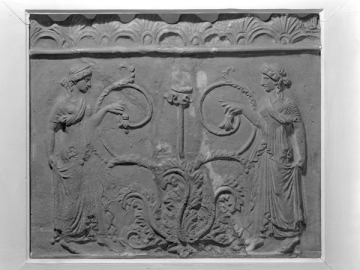Explore Collections


You are here:
CollectionsOnline
/
Roman roof Cresting Plaque depicting two women walking towards a stylised acanthus plant
Browse
Roman roof Cresting Plaque depicting two women walking towards a stylised acanthus plant
27 BC-14 AD
Augustan
Augustan
Terracotta
Height: 36.5cm
Width: 42cm
Width: 42cm
Museum number: M428
On display: Basement West Corridor
All spaces are in No. 13 Lincoln's Inn Fields unless identified as in No. 12, Soane's first house.
For tours https://www.soane.org/your-visit
Curatorial note
The women, in Archaistic dress and pose, are bending the budding stems of the acathus plant down with their outstretched left and right hands respectively as they pull up the edges of their skirts with their right and left hands respectively.
Group IV: Cresting plaque.
Von Rohden places this, judging by the foliate design, in Type II1 and cites a comparison for the strip of vegetation at the top2.
Soane's account of this antiquity in the 1830 Description of his house notes that it was found at the Villa Adriana, Tivoli, with others now in the Townley collection - today in the British Museum. He records that they were initially sent from Rome to Lyde Browne, a wealthy banker and antiquary who died in 1787. In both the 1830 and the 1835 Descriptions Soane quotes from an account of this terracotta by its most recent owner, Dr. Charles Chauncey: "Sculptures of this kind," says Dr Chauncey, "from the cheapness, probably, of the materials and the workmanship, were very generally in use among the Romans: and they often, at least, were not intended (as models in clay now usually are) as models only, for sculptures to be executed afterwards in more valuable materials, but were wrought for the purpose of being used at once as ornaments of houses and tombs. The general design of this sculpture relates probably to the subject most frequently alluded to in ancient mythology - the creation of all things: this seems to be pointed out by the active element of fire, and by the plant of the lotus, so often to be met with among the ancients on such occasions, as having the property of reproducing itself."
1 H. Von Rohden and H. Winnefeld, Die antiken Terracotten, vol. IV (Architektomische römische Tonreliefs der Kaiserzeit) pp. 210-212, cp. fig. 430.
2 H. Von Rohden and H. Winnefeld, Die antiken Terracotten, vol. IV., (Architektomische römische Tonreliefs der Kaiserzeit) pl. LXXIV.
Group IV: Cresting plaque.
Von Rohden places this, judging by the foliate design, in Type II1 and cites a comparison for the strip of vegetation at the top2.
Soane's account of this antiquity in the 1830 Description of his house notes that it was found at the Villa Adriana, Tivoli, with others now in the Townley collection - today in the British Museum. He records that they were initially sent from Rome to Lyde Browne, a wealthy banker and antiquary who died in 1787. In both the 1830 and the 1835 Descriptions Soane quotes from an account of this terracotta by its most recent owner, Dr. Charles Chauncey: "Sculptures of this kind," says Dr Chauncey, "from the cheapness, probably, of the materials and the workmanship, were very generally in use among the Romans: and they often, at least, were not intended (as models in clay now usually are) as models only, for sculptures to be executed afterwards in more valuable materials, but were wrought for the purpose of being used at once as ornaments of houses and tombs. The general design of this sculpture relates probably to the subject most frequently alluded to in ancient mythology - the creation of all things: this seems to be pointed out by the active element of fire, and by the plant of the lotus, so often to be met with among the ancients on such occasions, as having the property of reproducing itself."
1 H. Von Rohden and H. Winnefeld, Die antiken Terracotten, vol. IV (Architektomische römische Tonreliefs der Kaiserzeit) pp. 210-212, cp. fig. 430.
2 H. Von Rohden and H. Winnefeld, Die antiken Terracotten, vol. IV., (Architektomische römische Tonreliefs der Kaiserzeit) pl. LXXIV.
Soane's 1830 Description gives a full provenance describing this item: 'a terracotta of singular merit; it formerly belonged to Dr Chauncy who thus descrites it: "This antique Bas relief, of terra cotta clay, baked and hardened, was found in the ruins of the Emperor Adrian's Villa [Villa Adriana or Hadrian's Villa], near Rome, together with many others now in the collection of Chales Townley Esq. of Westminster. / From Mr Lyde Browne, to whom it was transmitted from Rome, it passed into the hands of a late eminent collector, Matthew Duane, Esq. at the sale of whose gems I [Dr Chauncy] purchased it'.
Soane again records in his later 1835 Description that this terracotta was once 'in the possession of Dr Chauncey' and that it was found in the ruins of the Emperor Hadrian's Villa at Tivoli, near Rome.
Dr. Chauncy/Chauncey was probably the physician and antiquarian Dr Charles Chauncey (1709–1777).
Literature
Sir John Soane, Description of the Residence of John Soane, Architect, 1835, pp.31-32.
Von Rohden, H., and Winnefeld, H., Die antiken Terracotten, vol. IV. 1,2, (Architektomische römische Tonreliefs der Kaiserzeit.), p.211
Sir John Soane, Description of the Residence of John Soane, Architect, 1832 [text identical to the 1830 edition], p.11
Von Rohden, H., and Winnefeld, H., Die antiken Terracotten, vol. IV. 1,2, (Architektomische römische Tonreliefs der Kaiserzeit.), p.211
Sir John Soane, Description of the Residence of John Soane, Architect, 1832 [text identical to the 1830 edition], p.11
Soane collections online is being continually updated. If you wish to find out more or if you have any further information about this object please contact us: worksofart@soane.org.uk





